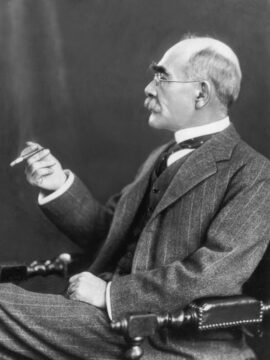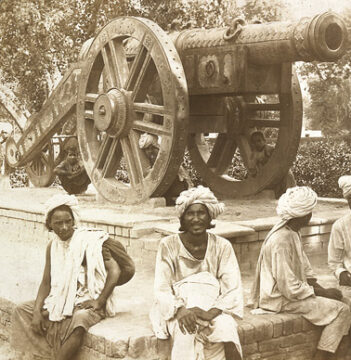by Daniel Shotkin

I was in 9th grade when I first heard the name Rudyard Kipling mentioned in school. My history teacher had decided to inaugurate a unit on imperialism, and Kipling’s zealous verses soon rang loudly through the classroom:
Take up the White Man’s burden—
Send forth the best ye breed—
Go bind your sons to exile
To serve your captives’ need;
To wait in heavy harness
On fluttered folk and wild—
Your new-caught, sullen peoples,
Half devil and half child.
My teacher explained that Kipling exemplified the racist and jingoistic attitudes of late-19th-century European colonial powers. I was surprised because, to me, Kipling represented something else entirely.
I didn’t disagree with my teacher’s assessment—certainly, no one could after hearing a poem called “The White Man’s Burden.” But my confusion wasn’t unwarranted; it stemmed largely from the fact that the Kipling recited by my teacher and the Kipling I had known prior to that fateful history class seemed to be two radically different authors.
My first encounter with Kipling was categorically less ominous. One of my favorite bedtime stories as a kid was “Rikki-Tikki-Tavi,” a short tale about a mongoose protecting a family from two cobras. Apart from that and other indirect encounters—animated versions of The Jungle Book and the song “Bare Necessities”—Kipling and I didn’t interact until I was 11, when my dad insisted that I read Kim.
As is often the case with lengthy Victorian epics, Kim’s very first pages didn’t particularly captivate me. In fact, Kipling’s dense, tangent-filled prose made me put the book down just minutes after I had picked it up. But months later, I gave it another go, trudged past the introduction, and realized that what I had in front of me was a novel about myself.
For those unfamiliar with the story, Kim follows a young Irish orphan named Kim O’Hara as he becomes embroiled in the political intrigue of British-ruled India. Among his many adventures, O’Hara is taken up as the disciple of a Tibetan lama, becomes employed by a British intelligence agency, and travels into the foothills of the Himalayas. Kim is a coming-of-age story, an adventure tale, and a geopolitical thriller all in one. I read it as a thrilling, if somewhat dated, Victorian ‘Spy Kids.’ What more could I ask for?

But never mind the plot—Kipling’s prose in Kim is so intricate it could easily be mistaken for poetry. Take the opening line, for example:
“He sat in defiance of municipal orders, astride the gun Zam-Zammeh, on her old platform, opposite the old Ajaib gher, the Wonder House, as the natives called the Lahore Museum. Who hold Zam-Zammah, that ‘fire-breathing dragon,’ hold the Punjab, for the great green-bronze piece is always first of the conqueror’s loot.”
Kipling manages to cram in action, exposition, and historical context into two sentences, all without stereotyping local culture—a novelty when compared to his Victorian predecessors. In fact, Kipling’s attitude toward India specifically stands in stark contrast to the racist and imperialist ideas he is known for today.
While Kipling refers to “new-caught, sullen peoples—Half devil and half child” in “The White Man’s Burden,” his depiction of the Indian subcontinent and its people in Kim, though idealized, is devoid of any overt stereotypes. He goes out of his way to convey the diversity of cultures and faiths in India, as well as the complexity of relations between the British and the native population. This is most clearly illustrated through Kim’s best friend, Mahbub—a Sunni horse dealer and fellow spy for the British. When Kim asks Mahbub about his experiences with the British, he replies, “It is with them as with all men—in certain matters they are wise, and in others most foolish.”
Read this dialogue between Kim and Mahbub and you’ll understand why I had such trouble attributing “White Man’s Burden” to Kipling.
Kim: “What am I? Mussalman, Hindu, Jain, or Buddhist? That is a hard knot.”
Mahbub: “Thou¹ art beyond question an unbeliever, and therefore thou wilt be damned. So says my Law—or I think it does. But…I love thee. Therefore I say in my heart the Faiths are like the horses. Each has merit in its own country.”
¹Kipling uses “thou” and “thee” to translate Hindustani’s informal register.
But back to my first impressions—why did I feel Kim was about me? Well, to me, Kim was the only novel I had read that reflected my own childhood experience.
Of course, I wasn’t involved in any child espionage, but there were other commonalities. You see, Kipling, Kim, and I all grew up in a country different from that of our parents. For Kipling, that meant being born in Bombay to British parents and living there intermittently throughout his life. I was born in New York to Russian parents, but my family moved to Bangkok, Thailand, when I was six months old. I lived there until I was 14.
Kipling’s childhood explains why he portrayed India with such care in his stories, and shows the conflict he felt between his Indian childhood and his adult imperialistic tendencies. Kipling summarizes this conflict in his memoirs:
“In the afternoon heats before we took our sleep, Meeta would tell us stories and Indian nursery songs all unforgotten, and we were sent into the dining room after we had been dressed, with the caution ‘Speak English now to Papa and Mamma.’ So one spoke ‘English,’ haltingly translated out of the vernacular idiom that one thought and dreamed in.”
My childhood was similarly multicultural. My friends were from all corners of the world—Singaporean, Indian, Chinese, French, Japanese, and, of course, Thai. I spoke Russian at home, English with my friends, Chinese to my teachers, and Thai to strangers. I grew up with the strange feeling of knowing I was always a foreigner (or farang, as we’re called in Thailand), but also with the belief that I could fit in anywhere in the world.
When I read about Kim O’Hara walking along the bustling Grand Trunk Road, I saw myself zipping through the equally bustling Bangkok rush-hour traffic on a motorbike taxi. Just as Kipling describes the pilgrimage of a Tibetan lama from the Ravi River to the Himalayas, I would see orange-robed Buddhist monks with alms bowls in hand walking past me on my way to school. And perhaps most importantly, just as Kim struggles to find a sense of identity between his British ancestry and Indian upbringing, I found it difficult to understand where I belonged when all I had grown up around was, at least on paper, alien.
But my childhood certainly wasn’t unique. ‘Third Culture Kids’—children who grow up in a culture different from that in which their parents grew up—are more common than ever. Bangkok today is home to 92 international schools that serve Third Culture Kids from all over the world, and the same can be said about every international city, be it London, Tokyo, New Delhi, or Mexico City. In this sense, Kim isn’t just a dated book on empire; it’s a novel that describes a situation more and more young people find themselves in today.
Kipling’s legacy as a preacher of imperialism is problematic, and rightfully so. But his work doesn’t have to be viewed strictly within the confines of the 19th century. In fact, I would argue that Kim is, at its heart, a novel that beautifully conveys the uniquely 21st-century experience of being a Third Culture Kid.
His nickname through all the wards was ‘Little Friend of all the World.’
—Rudyard Kipling, Kim, 1901.
Enjoying the content on 3QD? Help keep us going by donating now.
